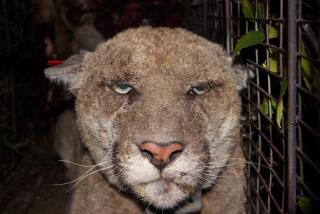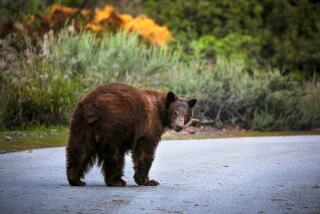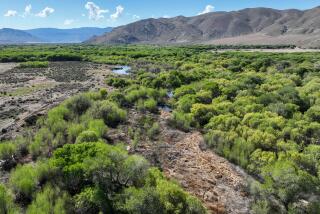Species Protection Relies More on Killing Predators
- Share via
COOS BAY, Ore. — Biologists Dave Lauten and Kathy Castelein were thrilled this spring to find four new western snowy plover nests on a stretch of bulldozed sand where they had spread countless buckets of oyster shells to create new habitat for the threatened shore birds.
“Then the ravens found them,” said Lauten, who with Castelein works for the Oregon Natural Heritage Information Center to build up snowy plover numbers on the southern Oregon Coast.
“Within a few days they found all the nests,” said Lauten. “You never have a lot of ravens. It’s always two. Once they figure it out, you see them cruise around low. Whenever they see a plover or a killdeer, they land and start walking around and they pick at everything.”
Plovers that lose their nests to predators would normally fly off to a new stretch of bare sand and lay more eggs. But since the 1950s, exotic species such as European beach grass have moved in and covered the dunes.
All Lauten and Castelein could do in the past was put a wire cage over the nests and hope for the best. Now they routinely work with federal trappers who kill the ravens, red foxes and feral cats that prey on plover nests. In the short term, plovers have hatched more chicks. But without more habitat, the long-term prospects for the bird remain precarious, they said.
Predator control on behalf of threatened and endangered species has never been greater. Last year Wildlife Services, a division of the U.S. Department of Agriculture best known for shooting coyotes that prey on sheep and cattle, spent $3.5 million trapping and killing predators on behalf of 243 different species of plants and animals. That amounts to 19% of the 1,268 plants and animals protected by the Endangered Species Act.
Financed largely by cooperative agreements with states, Wildlife Services agents put out poisoned eggs for ravens that poke their beaks into the soft shells of young desert tortoises in California’s Mojave Desert, poison and shoot badgers and coyotes that prey on black-footed ferrets in the South Dakota plains, and trap foxes eating the eggs of sea turtles on Florida beaches.
“Generally, you would have to say that as the habitats decrease or the numbers decrease, then predation becomes more of a critical factor in the survival of the species,” said Pete Poulos, a staff officer for Wildlife Services in Washington, D.C.
The western snowy plover is a prime example, said John Marzloff, a professor of wildlife science at the University of Washington. Numbers are low, habitat is scarce and predators are plentiful.
“I think it’s mainly driven by human changes in the landscape that have made it very favorable for [predators] by increasing food, water or habitat,” said Marzloff. “It’s a phenomenon that is occurring not just in the western United States, but is occurring in Russia, Europe, lots of different places.”
Those changes include more garbage dumps, more fast food tossed out of cars, and more homes in the desert, providing food and water that ravens never had before, so more of their young survive and they can live places they couldn’t live before, Marzloff said.
Kieran Suckling, policy director for the Center for Biological Diversity, said there would be no need for predator control if there were more habitat.
“By giving up even the prospect of protecting ecosystems, we are forced to spend vast amounts of money managing what are effectively outdoor zoos,” said Suckling. “If instead we protected large swaths of habitat and increased population sizes, then it wouldn’t matter if a few birds got picked off by predators.”
The U.S. Fish and Wildlife Service considers predator control case by case, said agency spokesman Chris Tollefson.
“Certainly it is not a substitute for habitat protection,” Tollefson said. “Predation is part of the natural process. Unless there is something really throwing that out of whack to the degree of something excessive, it’s not something we look to do.”
That’s what happened in Alaska’s Aleutian islands in the 1960s, after red foxes escaped from fur farms and started preying on nests of the Aleutian cackling goose. The population dropped below 1,000. Wildlife Services started killing foxes, biologists transplanted geese to new islands and their numbers grew back quickly, so the goose was taken off the endangered species list in 2001.
Restoring habitat can put predators in their place. In the early 1990s, biologists wanted to start killing coyotes to reverse declines in pronghorn populations on the Hart Mountain National Antelope Refuge in Eastern Oregon. But after environmentalists won a court order banning livestock from the refuge, pronghorn populations started to rise, even without killing coyotes. No cows meant more food and cover for pronghorns.
With the plover, most deaths involved predators, said Dave Williams, Oregon state director for Wildlife Services.
“If they want to generate numbers, they’ve got to do something with one of the most significant mortality factors,” said Williams. “That’s why we’re involved here in Oregon.”
It has worked in the short term.
Since Wildlife Services began killing plover predators in 2002, nesting success has risen dramatically.
Last year, the 140 plovers in Oregon produced 107 young that survived long enough to fly, compared to 60 in 2003 and an average of 37 since monitoring began in 1990, according to Fish and Wildlife.
Wildlife Services spent $70,985 on plovers in Oregon in 2004, and $213,908 in California. In 2003 they spent $52,952 in Oregon and $201,698 in California.
Lauten and Castelein worry about the long term.
“The problem really is there is a limited amount of habitat,” he said.
More to Read
Sign up for Essential California
The most important California stories and recommendations in your inbox every morning.
You may occasionally receive promotional content from the Los Angeles Times.










